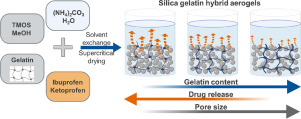当前位置:
X-MOL 学术
›
Acta Biomater.
›
论文详情
Our official English website, www.x-mol.net, welcomes your feedback! (Note: you will need to create a separate account there.)
Gelatin content governs hydration induced structural changes in silica-gelatin hybrid aerogels - Implications in drug delivery.
Acta Biomaterialia ( IF 9.7 ) Pub Date : 2020-01-15 , DOI: 10.1016/j.actbio.2020.01.016 Mónika Kéri 1 , Attila Forgács 2 , Vanda Papp 3 , István Bányai 1 , Péter Veres 4 , Adél Len 5 , Zoltán Dudás 6 , István Fábián 2 , József Kalmár 2
Acta Biomaterialia ( IF 9.7 ) Pub Date : 2020-01-15 , DOI: 10.1016/j.actbio.2020.01.016 Mónika Kéri 1 , Attila Forgács 2 , Vanda Papp 3 , István Bányai 1 , Péter Veres 4 , Adél Len 5 , Zoltán Dudás 6 , István Fábián 2 , József Kalmár 2
Affiliation

|
Silica-gelatin hybrid aerogels of varying gelatin content (from 4 wt.% to 24 wt.%) can be conveniently impregnated with hydrophobic active agents (e.g. ibuprofen, ketoprofen) in supercritical CO2 and used as drug delivery systems. Contrast variation neutron scattering (SANS) experiments show the molecular level hybridization of the silica and the gelatin components of the aerogel carriers. The active agents are amorphous, and homogeneously dispersed in these porous, hybrid matrices. Importantly, both fast and retarded drug release can be achieved with silica-gelatin hybrid aerogels, and the kinetics of drug release is governed by the gelatin content of the carrier. In this paper, for the first time, a molecular level explanation is given for the strong correlation between the composition and the functionality of a family of aerogel based drug delivery systems. Characterization of the wet aerogels by SANS and by NMR diffusiometry, cryoporometry and relaxometry revealed that the different hydration mechanisms of the aerogels are responsible for the broad spectrum of release kinetics. Low-gelatin (4-11 wt.%) aerogels retain their open-porous structure in water, thus rapid matrix erosion dictates fast drug release from these carriers. In contrast to this, wet aerogels of high gelatin content (18-24 wt.%) show well pronounced hydrogel-like characteristics, and a wide gradual transition zone forms in the solid-liquid interface. The extensive swelling of the high-gelatin hybrid backbone results in the collapse of the open porous structure, that limits mass transport towards the release medium, resulting in slower, diffusion controlled drug release. STATEMENT OF SIGNIFICANCE: Developing new drug delivery systems is a key aspect of pharmaceutical research. Supercritically dried mesoporous aerogels are ideal carriers for small molecular weight drugs due to their open porous structures and large specific surface areas. Hybrid silica-gelatin aerogels can display both fast and retarded drug release properties based on the gelatin contents of their backbones. The structural characterization of the aerogels by SANS and by NMR diffusiometry, cryoporometry and relaxometry revealed that the different hydration mechanisms of the hybrid backbones are responsible for the broad spectrum of release kinetics. The molecular level understanding of the functionality of these hybrid inorganic-biopolymer drug delivery systems facilitates the realization of quality-by-design in this research field.
中文翻译:

明胶含量控制水化诱导的二氧化硅-明胶混合气凝胶的结构变化-对药物传递的影响。
可以在超临界CO2中方便地将疏水明胶含量(从4 wt。%到24 wt。%)的二氧化硅-明胶混合气凝胶充满疏水活性剂(例如布洛芬,酮洛芬),并用作药物输送系统。对比变化中子散射(SANS)实验表明,二氧化硅与气凝胶载体中明胶成分的分子水平杂交。活性剂是无定形的,并且均匀地分散在这些多孔的混合基质中。重要的是,用二氧化硅-明胶混合气凝胶既可以实现快速释放又可以延迟药物释放,并且药物释放的动力学取决于载体中明胶的含量。在本文中,这是第一次 分子水平的解释给出了基于气凝胶的药物递送系统的组成和功能之间的强烈关联。通过SANS以及NMR扩散法,低温法和弛豫法对湿气凝胶进行表征,结果表明气凝胶的不同水合机理是释放动力学的广谱原因。低明胶(4-11 wt。%)气凝胶在水中保持其开孔结构,因此快速的基质侵蚀决定了药物从这些载体中的快速释放。与此相反,高明胶含量(18-24wt。%)的湿气凝胶表现出明显的水凝胶状特征,并且在固-液界面形成宽的逐渐过渡区。高明胶杂化骨架的广泛膨胀导致开放的多孔结构崩溃,限制了向释放介质的质量传输,从而导致药物扩散受扩散控制。意义声明:开发新的药物输送系统是药物研究的关键方面。超临界干燥的中孔气凝胶由于具有开放的多孔结构和较大的比表面积,因此是小分子量药物的理想载体。杂化硅胶-明胶气凝胶可基于其骨架中的明胶含量显示快速和延迟的药物释放特性。气凝胶的结构表征由SANS以及NMR扩散测定法,低温测定法和张弛测定法表明,杂化主链的不同水合机理是释放动力学的广谱原因。
更新日期:2020-01-15
中文翻译:

明胶含量控制水化诱导的二氧化硅-明胶混合气凝胶的结构变化-对药物传递的影响。
可以在超临界CO2中方便地将疏水明胶含量(从4 wt。%到24 wt。%)的二氧化硅-明胶混合气凝胶充满疏水活性剂(例如布洛芬,酮洛芬),并用作药物输送系统。对比变化中子散射(SANS)实验表明,二氧化硅与气凝胶载体中明胶成分的分子水平杂交。活性剂是无定形的,并且均匀地分散在这些多孔的混合基质中。重要的是,用二氧化硅-明胶混合气凝胶既可以实现快速释放又可以延迟药物释放,并且药物释放的动力学取决于载体中明胶的含量。在本文中,这是第一次 分子水平的解释给出了基于气凝胶的药物递送系统的组成和功能之间的强烈关联。通过SANS以及NMR扩散法,低温法和弛豫法对湿气凝胶进行表征,结果表明气凝胶的不同水合机理是释放动力学的广谱原因。低明胶(4-11 wt。%)气凝胶在水中保持其开孔结构,因此快速的基质侵蚀决定了药物从这些载体中的快速释放。与此相反,高明胶含量(18-24wt。%)的湿气凝胶表现出明显的水凝胶状特征,并且在固-液界面形成宽的逐渐过渡区。高明胶杂化骨架的广泛膨胀导致开放的多孔结构崩溃,限制了向释放介质的质量传输,从而导致药物扩散受扩散控制。意义声明:开发新的药物输送系统是药物研究的关键方面。超临界干燥的中孔气凝胶由于具有开放的多孔结构和较大的比表面积,因此是小分子量药物的理想载体。杂化硅胶-明胶气凝胶可基于其骨架中的明胶含量显示快速和延迟的药物释放特性。气凝胶的结构表征由SANS以及NMR扩散测定法,低温测定法和张弛测定法表明,杂化主链的不同水合机理是释放动力学的广谱原因。


























 京公网安备 11010802027423号
京公网安备 11010802027423号